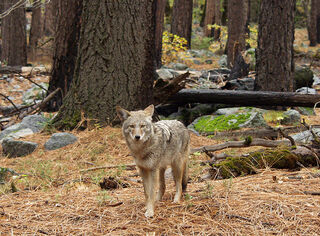Forgiveness
Prying Open the Secrets of Dog Domestication
Wolves, coyotes, and dingoes share more with dogs than it seems.
Posted June 13, 2021 Reviewed by Gary Drevitch
I want to begin this post with an apology and a thank-you to all my loyal readers who began with Dog’s Best Friend nine years ago, long before a pandemic ever entered our imagination, except for the minds of a few overheated science writers who correctly cited people who predicted the world would suffer such a calamity.
I want to thank those who have stuck with me through thick and now through thin. My production has slowed tremendously in the past few years due to Parkinson's disease, which now makes it difficult for me to type with any speed or accuracy. I have to rely on my wife, Gina, and the kindness of others to get this thing out in any kind of regular fashion, and I’m not doing a very good job. I will try to become more regular in my postings, perhaps by hiring an assistant, which I’ve long thought of doing.
Today, I want to talk about my three favorite wild canids — wolves, dingoes, and coyotes. Let’s begin with wolves and how the dog became the dog, or how the dog evolved from wolves; who those wolves were; where they were; and when it might have happened. The questions are still up in the air, and it may be that we haven’t been asking them in the right way or we may not be looking at the evidence right in front of our eyes. The latter, I believe, is the case more than the former. As I’ve pointed out many times, it seems that dogs are a result of shifting emphasis, as it were, in the wolf genome, in terms of behavior, sociability, and the like.
What I mean by that is that there has long been an assumption that between wolves and humans there exists an undying enmity that arose from their first encounter. I am raising this issue again because it has achieved the status of received wisdom that early modern humans could not possibly have been dumb enough to welcome into their homes stone-cold killers. The notion was that the wolf was a natural-born competitor of humans in the grand evolutionary scheme and a natural haters of humans. This seems highly unlikely and here’s why: Wolves and humans have very similar social structures. They are both highly motivated group animals who share their resources and the necessity of taking care of their young, although wolf pups age more quickly than human babies. We have evidence from anthropology, and some archaeological records, that Homo sapiens, Homo erectus, and perhaps even Homo neanderthalis were associated with wolves for tens of thousands of years before wolves produced the morphological dog. So what happened?
First, humans have a propensity for bringing all sorts of animals into shelter. There’s ample evidence of that from prehistory on. For example, we find the Anu, the aboriginal people of Japan, who brought bears into their homes and raised them until the bears became too big to handle. (Wolves are considerably more social than bears, of course.)
Looking at the mythologies of various peoples, we find many stories of peoples who take as their founder a dog or a wolf, as among many North American Indians, who had dog-based origins myths. In ancient Rome, the founders of the city, Romulus and Remus, were said to have been nursed by a she-wolf. A cursory survey of the world’s literature reveals more instances of people getting along with wolves and people slaughtering wolves than of wolves massacring people.

In some cultures, the founding being is not a wolf, but a dingo or coyote. Among the aboriginal people of Australia, one group has declared, “The dingo is who we would be if we were not who we are.” I think that is an accurate and good description that seems to me also to throw into question whole discussion that has taken place in Australia since white Europeans first invaded over the nature of the dingo as a separate species of wild canids or merely another type of dog whose evolution has been shaped by its long years of isolation and, more recently, by senseless persecution by humans. In a recent article in American Scientist, paleoanthropologist Pat Shipman examines various aspects in the ongoing debate over dingoes and their management.

There has long been a debate about whether coyotes have contributed anything to the dog genome, with the consensus being they did not. However, last year, researchers from the University of New Mexico analyzed bone fragments of coyotes, wolves, and domesticated dogs from a pueblo southeast of Santa Fe. In remains dated between 1300 and 1420 A.D., they found what appears to be a coyote who, for all intents and purposes seems to have been given the preferential treatment normally associated with dogs.
The interaction of Australian aboriginals with dingoes also points to certain aspects of dog origins — that is, Aborigines adopt these animals and when they reach maturity, they go off. They may give birth near the human encampment, or at a greater distance if they are less socially inclined. There was an argument made recently that dingoes raised in camps then formed an intermediate population of animals that continued to have an association with people. If true, this line of thinking undermines the accepted dualism of wild vs. domestic.


